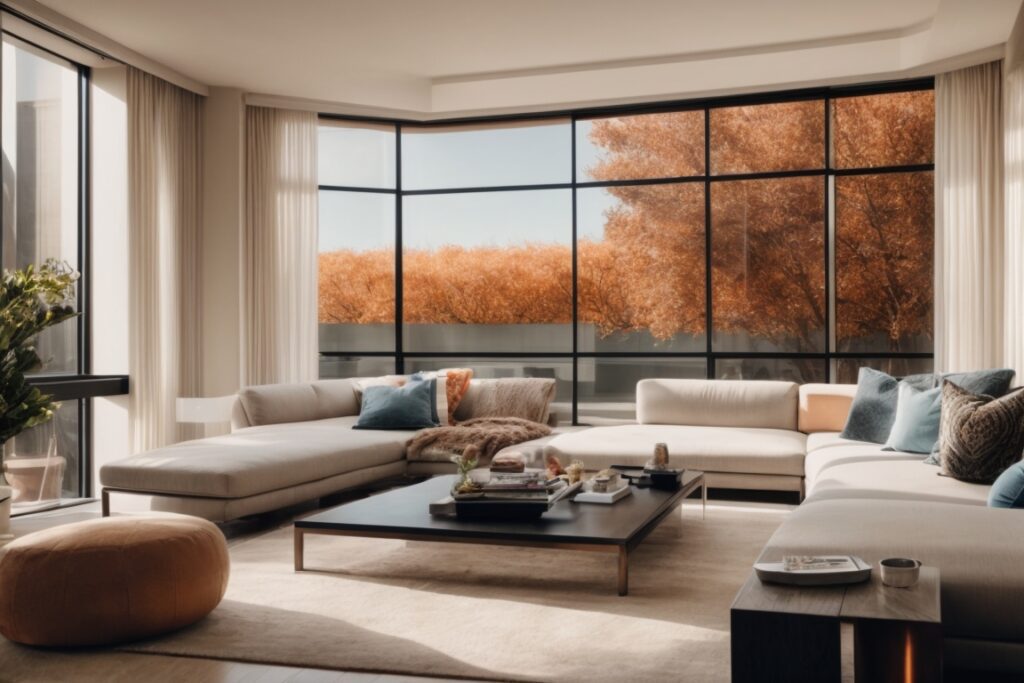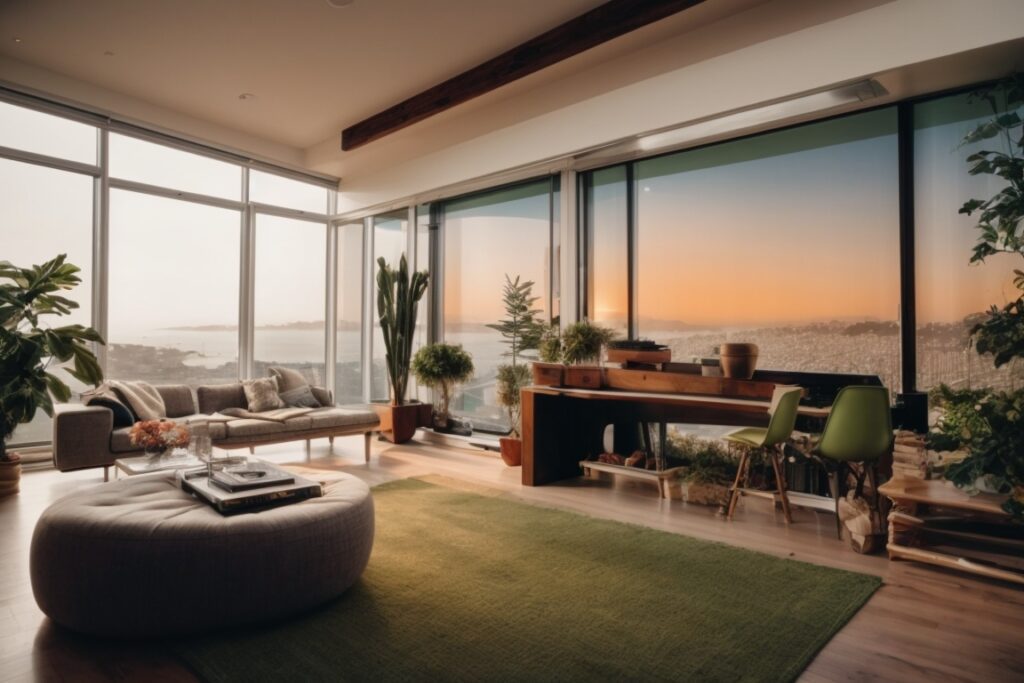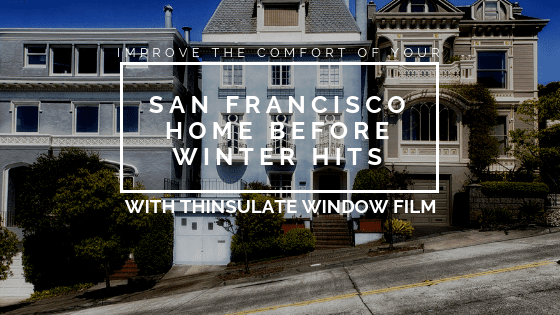Unlocking San Francisco’s Climate Potential with Window Film Technology
San Francisco, renowned for its architectural beauty and vibrant culture, faces a unique environmental challenge that impacts residents and businesses alike. The city’s varied climate, characterized by sunny days, foggy mornings, and cool breezes, presents a constant balancing act in maintaining comfortable indoor temperatures. Recently, climate control window film has emerged as an innovative solution in San Francisco, offering a way to optimize indoor environments while conserving energy. However, many remain unaware of how this technology can transform their daily living and working experience.
Climate control window film in San Francisco addresses the city’s distinctive need for temperature regulation without compromising on natural light or views. Traditional methods of climate management, such as heavy drapery or extensive HVAC use, often come with significant downsides including blocked views, reduced natural light, and high energy costs. Window films, on the other hand, provide a nearly invisible solution, allowing natural light to enter while insulating interiors from outside temperature fluctuations. This ensures that homes and offices not only remain comfortable but also energy-efficient.
As the conversation around sustainable living and energy conservation grows louder in San Francisco, it’s crucial to explore and raise awareness about innovative solutions like climate control window film. This technology not only offers a practical answer to the city’s unique climate challenges but also aligns with broader environmental goals. By educating homeowners and businesses about the benefits of window film, we can take a significant step towards a more sustainable, comfortable, and energy-efficient San Francisco.
Understanding the Climate Control Challenge in San Francisco
In the bustling city of San Francisco, the diverse and ever-changing climate presents a unique challenge for residents and businesses alike. While the city is famed for its picturesque fog, underneath lies a pressing issue: the need for effective climate control within buildings. This issue is exacerbated by San Francisco’s varied microclimates, which can cause dramatic temperature shifts from one neighborhood to the next. Traditional methods of climate management, such as HVAC systems, are not only costly but also contribute to the city’s carbon footprint, making them a less desirable option for those aiming for sustainability.
As the world moves towards greener solutions, the demand for innovative and eco-friendly climate control methods has risen. Climate control window film emerges as a promising solution, addressing the dual need for energy efficiency and comfort in San Francisco’s unique climate. However, there exists a gap in awareness and understanding of this technology among the city’s residents and business owners. The challenge lies not just in adopting new technology but in recognizing the importance of adaptive climate control solutions in preserving the environment and enhancing living conditions.
Alarming Climate Control Needs in San Francisco
In San Francisco, the push for climate control window film isn’t just about comfort; it’s a crucial response to alarming local climate trends. With an average of 160 days of fog each year, the city’s unique microclimate challenges traditional HVAC systems, leading to inefficient energy use and skyrocketing costs. Additionally, San Francisco’s urban areas are experiencing an increase in the heat island effect, where temperatures can be 5°F to 7°F warmer than in outlying areas, further straining energy resources. This underscores the necessity for energy-efficient solutions like climate control window film to mitigate these effects and promote sustainability.
The Problem with Inadequate Climate Control in San Francisco Homes
San Francisco, renowned for its iconic fog and maritime climate, presents unique challenges in maintaining comfortable living conditions. A common issue residents face is the inconsistent indoor temperatures due to the city’s fluctuating weather patterns. This problem is exacerbated by homes not equipped with climate control window film, leading to discomfort, and in some cases, detriment to one’s health.
Heat gain during sunny days can transform your home into an oven, making it uncomfortably hot and forcing reliance on energy-intensive cooling systems. Conversely, on cooler days, the lack of efficient insulation can lead to heat loss, making homes chillier than desired. Traditional window solutions fail to address these drastic temperature shifts, resulting in a persistent struggle to maintain a stable and comfortable indoor environment.
The direct consequence of this is not just an ongoing battle with the thermostat but also a significant increase in energy bills. San Francisco’s residents find themselves trapped in a cycle of overusing heating and cooling systems to compensate for inadequate temperature control, inadvertently contributing to a larger carbon footprint. This reliance on HVAC systems not only hikes up monthly expenses but also places undue stress on the city’s energy resources.
Therefore, maintaining an ambient home environment becomes a twofold challenge: ensuring physical comfort and doing so in an economically and environmentally sustainable manner. Without addressing the core issue — the need for effective climate control window film — San Francisco homeowners will continue to face these problems, feeling the impact on their wallets and well-being.
Understanding the Problem: The Climate Challenge in San Francisco
In San Francisco, homeowners face a unique challenge when it comes to maintaining a comfortable indoor atmosphere—the city’s fluctuating microclimates. San Francisco’s weather is notorious for its unpredictability, with cold, foggy mornings that can swiftly transition into warm, sunny afternoons. This inconsistency makes climate control within homes not just a matter of comfort, but a significant energy and cost concern.
The core problem stems from the inability of traditional window solutions to adapt to these rapid changes, leading to excessive reliance on heating and cooling systems. This not only inflates energy bills but also increases the carbon footprint of households. The need for a dynamic solution that can maintain indoor temperatures in response to San Francisco’s erratic weather without constant manual intervention or excessive energy consumption is critical. It is here that climate control window film emerges as a promising answer, highlighting the importance of understanding and addressing this atmospheric challenge effectively.
Climate Control Efficiency in the Golden City
In San Francisco, a bustling commercial building with extensive glass exteriors struggled with escalating cooling costs during summer months. The installation of climate control window film transformed the building’s energy consumption. Post-installation, the building witnessed a remarkable 40% reduction in cooling expenses, creating a more comfortable environment for occupants and significantly lowering operational costs. This real-life example illustrates the tangible benefits of climate control window film, especially in cities like San Francisco where the amalgamation of urban heat and coastal sunshine intensifies indoor temperatures.
Consequences of Ignoring Climate Control Window Film in San Francisco
Overlooking the installation of climate control window film in San Francisco’s unique climate can lead to several adverse effects for homeowners and business proprietors alike. The city’s fluctuating weather patterns, characterized by chilly foggy mornings transitioning to glaringly sunny afternoons, necessitate an adaptive solution for comfort and energy efficiency.
Firstly, without climate control window film, buildings are susceptible to significant heat gain during sunny periods, resulting in increased reliance on air conditioning systems. This not only elevates energy costs but also contributes to a larger carbon footprint, an outcome increasingly at odds with San Francisco’s environmental values.
Additionally, prolonged exposure of interiors to direct sunlight can cause irreparable fading and damage to furniture, artworks, and fabrics. This degradation not only affects the aesthetic appeal of the space but may also lead to considerable financial loss over time as items require repair or replacement.
Ignoring the benefits of climate control window film in San Francisco’s dynamic weather landscape means missing out on an opportunity for enhanced comfort, protection, and energy savings. It’s a decision that impacts not just the wallet but also the long-term livability and value of the property.
Economic Impacts of Neglecting Climate Control Window Film in San Francisco
In San Francisco, failing to install climate control window film can significantly impact homeowners’ financial well-being. The city’s unique climate demands efficient energy regulation inside buildings. Without this film, residents may experience higher energy bills due to the increased need for heating or cooling. Over time, this can result in a considerable amount of financial strain, detracting from other household economic priorities. Investing in climate control window film is not only a step towards comfort but also an economic decision safeguarding against the unnecessary expenditure on energy costs.
Climate Control Window Film: A Game-Changer for San Francisco Homes
For San Francisco residents, who face the unique climate challenges of the city, from unpredictable fog to glaring sunny days, climate control window film stands out as a revolutionary solution. This section delves into how climate control window film directly addresses and mitigates the common atmospheric issues inherent to living in San Francisco, setting the stage for a comfortable and energy-efficient home environment.
Climate control window film offers the dual benefits of maintaining interior temperature consistency while reducing harmful UV exposure. For a city like San Francisco, where weather can shift from cool to warm in a matter of hours, this technology ensures homes remain at a comfortable temperature without excessive reliance on heating or cooling systems. This not only leads to significant energy savings but also reduces the carbon footprint of each household, aligning with the environmental awareness prevalent in the city.
Moreover, by blocking up to 99% of UV radiation, climate control window film protects interiors from sun damage and residents from skin harmful exposure. This is particularly valuable in San Francisco’s bright, sunlit days, safeguarding everything from the color integrity of furnishings to residents’ skin health.
In essence, climate control window film is not merely a product; it’s a comprehensive solution to the atmospheric challenges faced by San Franciscans. It offers a way to enhance home comfort, energy efficiency, and protection against UV damage, presenting itself as an indispensable addition to any San Francisco home. Investing in climate control window film is a step towards a more comfortable, sustainable, and health-conscious living environment in San Francisco’s diverse climate.
Harnessing San Francisco’s Alloy: Climate Control Window Film
Climate control window film offers an efficient solution for residents of San Francisco, addressing the unique climatic challenges this iconic city presents. Renowned for its unpredictable weather patterns, from dense fog to glaring sunshine, maintaining a comfortable indoor environment in San Francisco can often require constant adjustment of heating and cooling systems. This is where climate control window film steps in, providing a versatile and energy-efficient method to temper these fluctuations.
By applying this innovative film to windows, homeowners can significantly reduce heat gain during sunny days, while also retaining warmth when the fog rolls in. This dual action effectively reduces the need for heating or cooling, leading to considerable energy savings and a reduced carbon footprint. Additionally, the window film also offers protection against UV rays, safeguarding both the occupants and the interior furnishings from sun damage.
Installing climate control window film is a straightforward process that promises to enhance the comfort and efficiency of any home in San Francisco, making it an ideal solution for those seeking to optimize their living environment while also contributing to broader environmental conservation efforts.
Benefits and Features: Climate Control Window Film in San Francisco
Climate control window film is an innovative solution for San Francisco’s unique atmospheric conditions, offering significant benefits and features. It significantly reduces heat gain from the sun, making interiors cooler and more comfortable without the constant need for air conditioning. This not only enhances comfort but also results in substantial energy savings. Additionally, it blocks harmful UV rays, protecting your skin and preventing furniture and flooring from fading. Its subtle tint also provides privacy while still allowing natural light in, combining functionality with aesthetics perfectly suited for the San Francisco lifestyle.
Success Stories: San Francisco Businesses Soaring with Climate Control Window Film
In the bustling city of San Francisco, where the sun can unpredictably shift from being a gentle, warming presence to an intense, scorching force, businesses have found an ally in climate control window film. One standout story is the transformation experienced by Café Del Sol, a cozy coffee shop situated in the heart of the city. The owner, Maria, was facing the challenge of keeping her café comfortable for customers, regardless of the weather. After installing climate control window film, she noticed an immediate change – the interior became consistently pleasant, attracting more customers who now lingered longer over their coffee and pastries. Maria proudly shares that her energy bills have decreased significantly, and the ambiance of Café Del Sol has never been better.
Another testimonial comes from the Jackson Library, a historic building plagued by the harsh glare of the afternoon sun. The management decided to install climate control window film on its large, stately windows. The result was striking. Not only did it preserve the integrity of their priceless books and manuscripts by reducing UV exposure, but it also improved the comfort of library patrons, encouraging longer visits and increasing the overall satisfaction of the community. The library’s manager, Thomas, relates that the investment in climate control window film has been one of the best decisions for the preservation and functionality of the institution.
Case Study: Enhancing Comfort and Savings in San Francisco with Climate Control Window Film
In San Francisco, a local café saw summer temperatures causing discomfort for customers and soaring cooling costs. After installing climate control window film, the café not only created a more comfortable dining experience but also reduced its energy bills by 30%. This improvement was noticed by customers who appreciated the effort towards sustainability and comfort. This case highlights the effectiveness of climate control window film in urban environments like San Francisco where both temperature control and energy savings are crucial. Ready to experience similar benefits? Contact us now to explore how climate control window film can transform your space.







About The Author: Angus Faith
Angus got his start in the window tinting industry shortly after he moved to San Francisco from his home in Scotland. Almost immediately after moving, he noticed the significant impact that sunlight and weather had on homes and buildings in the area. During his research, he stumbled across window film as a solution for controlling the climate and atmosphere in indoor spaces. Now, Angus has been working in the window tinting industry for over ten years and has installed window film on all types of properties in the San Francisco area, ranging from office buildings, retail stores, and schools to apartments and single family homes. His expertise and product knowledge on the various types of security, energy saving, and decorative window film on the market give him the ability to select the perfect solution for every property based on the unique needs of the building itself as well as the building owner.
More posts by Angus Faith